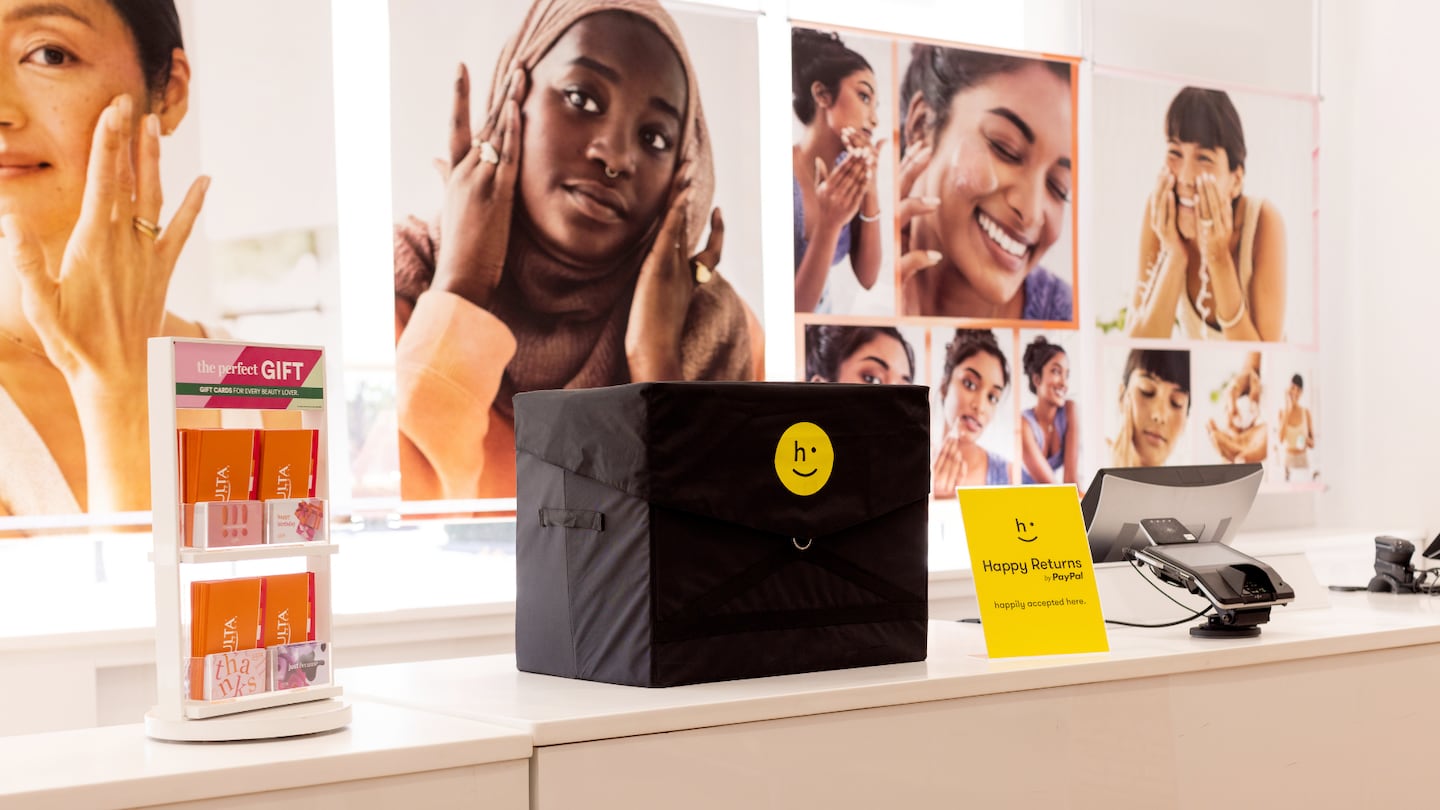
The Business of Fashion
Agenda-setting intelligence, analysis and advice for the global fashion community.

Agenda-setting intelligence, analysis and advice for the global fashion community.

Returns are an on-going logistical challenge for fashion retailers, with significant implications on how sustainable their operations are. Whether preference-based, a faulty item, or a symptom of “bracketing,” in which consumers over-purchase multiple versions of items and return the undesired excess, millions of items are in transit for return every day.
The business of returns is a $206 billion industry. In 2021, 20 percent of online-bought products were returned, according to a Shopify report, contributing significantly to fashion’s carbon footprint. Return shipping in the US alone is estimated to produce 15 million metric tonnes of carbon emissions annually.
Today, consumers increasingly expect a convenient returns process, with the flexibility to return e-commerce orders in-person as well as via mail. What’s more, 62 percent of customers expect an exchange or refund within 30 days of purchase, requiring a quick turnaround.
E-commerce returns company Happy Returns launched in 2015 and was acquired by PayPal in 2021. The company helps brands optimise their returns process to save money, retain revenue by promoting intelligent exchanges, boost sustainability, and make returns more delightful for shoppers.
In the US, Happy Returns offers an in-person, aggregated returns service through a network of more than 5,000 brick-and-mortar locations, such as FedEx, Staples, Ulta Beauty and Cost Plus World Market. Some 78 percent of the American population lives within a 10-mile radius of a “Return Bar”.
Consumers’ refunds are immediately generated during the Return Bar drop-off, helping to maintain customer satisfaction and an NPS of 93, while merchants benefit from significantly reduced shipping costs and packaging waste and the Return Bar locations, such as Ulta Beauty, benefit from increased foot traffic. Happy Returns software is available to all merchants and software fees are waived for any merchants that offer PayPal as one of their payment methods to their shoppers.

Now, BoF sits down with David Sobie, co-founder of Happy Returns, to learn more about how the company works with retailers, its focus on environmental solutions, and its plans to expand operations globally.
How do returns and reverse logistics fit into the overarching e-commerce journey?
Returns is one of those counterintuitive components of what we do in e-commerce. It’s easy to think, if your return rate is 20 percent, that must mean that only 20 percent of customers interact with returns.
But the reality is, most people will look at the returns policy before they check out, and a lot of consumers will decide whether they’re going to buy something online or in-person based on the anticipated returns fee. So, it has a huge impact on whether people end up buying from you.
What are consumer expectations around returns today?
Consumer expectations on returns have changed. Shoppers expect every merchant to cover the cost of shipping returns, meaning shoppers expect returns for free — but free means a merchant has to subsidise returns.
Returns actually impact, first of all, whether a customer is willing to buy from you; they have an impact on conversion before customers hit the “buy” button; and then they have an impact on retention. We know that 84 percent of shoppers will reject retailers that deliver a poor returns experience. In a world where customer acquisition is getting more expensive, you can’t afford to lose people because they had a bad returns experience.
Online, in a world where things are manufactured all over the world, one size does not necessarily correlate across brands, and people know that. So, they shop differently as a result.
As an industry, we also talk about shopping in-store and online, but shoppers don’t think about omnichannel in that way — they just think of it all as “shopping”. Within that shopping experience, consumers care about convenience and choice. That mindset extends to the returns process — consumers want to be able to return their items in the easiest, fastest way, and a bad returns process means a consumer is less likely to shop with you again.
What logistical challenges do brands and retailers face in the returns process?
The logistics, cost and volume of returns are a growing problem. As more shopping takes place online, return rates for e-commerce tend to be 3 to 4 times higher than brick-and-mortar. If I walk into the store, maybe I try a shirt on, I can touch it, I feel it — there’s a lot of data I receive before I check out.
Online, in a world where things are manufactured all over the world, one size does not necessarily correlate across brands, and people know that. So, they shop differently as a result. For example, with bracketing, you are over-buying already with the intention of returning some of the items.
Then, logistics costs are getting more expensive — it is expensive to ship items, especially if you are subsidising expenses to meet shoppers’ expectations with returns for free — and the cost to fund returns through mail has gone up. Absorbing that cost will have a direct impact on merchants’ bottom line.
What can a reverse logistics partner offer?
Merchants are good at a lot of things, but reverse logistics does not tend to be one of them. We represent this idea of omnichannel returns, that just happens to be in the place that the consumer would want it to be. While there has always been an opportunity for brands with storefronts to optimise and diversify the returns methods they offer their shoppers, we also enable buy online, return in store for merchants without stores — and we become the storefront.
We remove that friction of the mail for consumers: the wait, the hassle, the printing of labels. After starting the process online, a Happy Returns transaction takes about 30 seconds at one of our 5,000 Return Bars across the US, and the consumer will receive their refund instantly.
We aggregate items together, which saves a significant amount on the cost of shipping per unit, as well as offer an environmental benefit, and we can then pass on some of those savings to merchants.
How does Happy Returns work with its brand partners?
On the technical side, if I needed to return or exchange an item from one of our merchants, say Everlane or Revolve, their returns page is run by Happy Returns software. It is branded “Everlane,” for example, but it is our software.
Merchants are good at a lot of things, but reverse logistics does not tend to be one of them. We represent this idea of omnichannel returns, that just happens to be in the place that the consumer wants it to be.
Throughout this process, we can collect all kinds of data on the return reasons, which is available to merchants if they want to understand why or who is searching for the location partner. We also facilitate an exchange option wherever possible so merchants are able to retain sales. The software presents a QR code to facilitate an easy drop-off, or they have the option to mail it, but over 75 percent of shoppers using our software choose in-person drop-off as it’s easier for them and they get their refund initiated on the spot.
On the physical location side, our Return Bars are run by our partners’ employees, making it a personalised brand experience for consumers’ returns interactions. So, when shoppers for Levi’s or Gymshark walk into a Return Bar, that is additional foot traffic for the Return Bar brands themselves. This also then gives the location partner a marketing opportunity to their returns community, like offering a discount on their in-store purchase.
How is the Happy Returns service a more sustainable solution?
If you think about traditional returns by mail, that involves cardboard boxes and individual items travelling from the customer back to the merchant. At Happy Returns, items can be dropped off at the physical locations box-free by shoppers, and then be aggregated and shipped together in large, reusable and recycled totes rather than a cardboard box. We can use these totes up to 100 times.
We then ship items from drop-off locations to our regional Return Hubs where we sort and label the returns and bulk-ship them back to the manufacturer. It’s a two-step process that uses reusable packaging to eliminate cardboard and labels from the equation, and eliminates trips by densely packaging items into one third of the box space.
What is the next strategic focus for Happy Returns?
The first is more of the same. We started the year with about 3,000 drop-off locations and we are marching quickly to having the biggest drop-off network in the US. More locations mean we are closer to the population and their choices — currently, we have grown to 5,000 plus locations nationwide and 78 percent of Americans live within a ten mile radius of a Return Bar.
The acquisition by PayPal is also enabling more merchants to take advantage of our software for free, which will boost our credibility in the market, and we are also talking about expanding our Return Bar footprint internationally.
There are already some well-established pick-up and drop-off networks in the UK, and there are companies doing paperless returns. So, we need to consider where we fit into these markets in a way that is relevant to the end-consumer. Now, we can tap into a team on the ground in London, with existing relationships with merchants and potential location partners that we can leverage, which is something you’d only be able to do as part of a big organisation like PayPal.
This is a sponsored feature paid for Happy Returns as part of a BoF partnership.
As the German sportswear giant taps surging demand for its Samba and Gazelle sneakers, it’s also taking steps to spread its bets ahead of peak interest.
A profitable, multi-trillion dollar fashion industry populated with brands that generate minimal economic and environmental waste is within our reach, argues Lawrence Lenihan.
RFID technology has made self-checkout far more efficient than traditional scanning kiosks at retailers like Zara and Uniqlo, but the industry at large hesitates to fully embrace the innovation over concerns of theft and customer engagement.
The company has continued to struggle with growing “at scale” and issued a warning in February that revenue may not start increasing again until the fourth quarter.